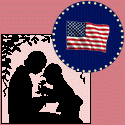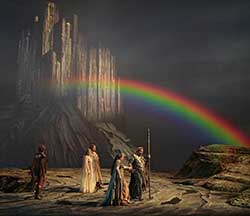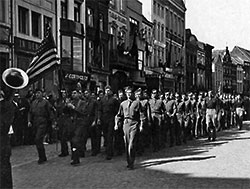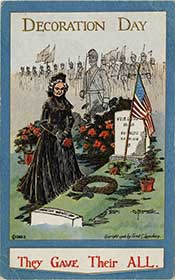What Do Mother’s Day and Memorial Day Have in Common?

Mother’s Day and Memorial Day. It’s hard to imagine two days more different: flowers, candy and a family dinner versus parades, ball games and a barbecue. Both fall in May, but the holidays share more than their place on the calendar — both arose from revulsion to the horrors of the American Civil War.

Honoring Mothers and War Heroes. People have always paid homage to their mothers and fallen war heroes. Ancient Greeks and Romans celebrated their mother goddess; fallen Nordic warriors were thought to live with gods in Valhalla. Yet early Americans never set aside specific days for public celebration of motherhood or battlefield sacrifice.
Mother’s Day. Mother’s Day arose from the separate efforts of several activist women. One was Julia Ward Howe, author of the Battle Hymn of the Republic. Dismayed by the loss of life in the American Civil War and the Franco-Prussian War, she issued a Proclamation for a Mothers’ Day for Peace. The idea was for women to unite so that mothers of one nation would not allow their sons to be trained to kill those of another. Woman’s Peace Festivals were held in Boston and other cities on June 2, 1873 and continued for several years, but the day never caught on.

The woman who created the national holiday was Anna Jarvis. In the 1850s, her mother, Ann Jarvis, established mothering clubs in western Virginia to help improve social conditions. This location placed them at the crossroads between North and South during the Civil War. Club members on both sides pledged to continue their friendship and goodwill despite the conflict and nursed soldiers from both sides. Mrs. Jarvis later organized a Mothers Friendship Day to help reunite families divided by the war.
Following her mother’s death in 1905, daughter Anna initiated political activities to create a public holiday. Her efforts bore fruit in 1914 when the second Sunday in May was proclaimed a national holiday honoring mothers.

Memorial Day. The holiday we call Memorial Day began with the Civil War practice of decorating the graves of fallen soldiers. Local people did this following such major battles as Gettysburg and Vicksburg and countless less heralded conflicts. In May 1865, African-Americans decorated the graves of Union soldiers in Charleston, S.C. Such observances were called Decoration Days.
Communities in both the North and the South continued this tradition after the war. In 1868, the commander of the Union veterans’ organization, General John Logan, called for May 30 to be designated Decoration Day for the purpose of “strewing with flowers, or otherwise decorating the graves of comrades who died in defense of their country.” The date was chosen because it was not associated with any specific Civil War event and, therefore, would honor all fallen soldiers equally.
Reconstruction governments in the post-war South did not honor fallen Confederate soldiers. So, local ladies’ associations marked and maintained the graves. The Richmond Dispatch in an 1870 editorial noted how the role of women in these commemorations made them all the more touching, commenting:

“It is the more impressive when … woman’s warm heart impels the observance, and the tribute paid to departed valor is only the placing of Spring’s brightest flowers upon the graves in which the soldiers’ bones repose.”
By 1890, every northern state observed May 30 as a holiday honoring fallen Union soldiers. This gave May 30 a partisan flavor, so Southern states chose different days to honor their dead. It was only after World War I when the holiday was changed to honor those who died in all wars, not just the Civil War, that everyone celebrated together. In 1968, Congress made Memorial Day the last Monday in May rather than the traditional May 30.
* * * * *
There is no official connection between Mother’s Day and Memorial Day. Still, it is interesting to see how both arose at the same time from the shared experience of the nineteenth century’s “Greatest Generation.”
-----
- Entry of the Gods into Valhalla, from Richard Wagner’s opera Das Rheingold. Photo Beatriz Schiller, Metropolitan Opera.
- Men of the 386th Bomb Group participate in Mother’s Day parade in St. Trond, Belgium, May 13, 1945. Image available at Ancestry.com.
- Postcard by C. Bunnell, published by Fred C. Lounsbury in 1908. Image from Smithsonian Institution.
- Each flag honors a Massachusetts resident killed in war since the Revolution. The monument at the back was built in 1877 to honor Massachusetts residents who died in the Civil War.
This article originally appeared in our free semi-monthly newsletter. To receive future issues, please add your name to the subscription list.

